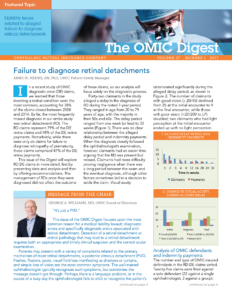“It’s just a PVD.”
GEORGE A. WILLIAMS, MD, OMIC Board of Directors
This issue of the OMIC Digest focuses upon the most common reason for a medical liability lawsuit: diagnostic errors and specifically diagnostic errors associated with retinal detachment. Detection of a retinal detachment or retinal pathology that may lead to a retinal detachment requires both an appropriate and timely clinical suspicion and the correct ocular examination.
Patients may present with a variety of complaints related to the primary mechanism of most retinal detachments, a posterior vitreous detachment (PVD). Flashes, floaters, spots, visual field loss manifesting as shadows or curtains, and simple loss of vision are the most common symptoms. The well-trained ophthalmologist typically recognizes such symptoms, but sometimes the message doesn’t get through. Perhaps there is a language problem, or in the course of a busy day the ophthalmologist fails to elicit or recognize the patient’s symptoms. Patients may fail to appreciate monocular symptoms or visual loss through denial or neglect. Unrecognized or unmentioned trauma may not be described for social or personal reasons. Regardless, it is our responsibility to determine the patient’s problem.
Once a diagnosis of retinal tear or retinal detachment is suspected, the ophthalmologist must proceed with an appropriate examination. The question of what constitutes an appropriate examination is often the focus of a medical liability claim. The American Academy of Ophthalmology Preferred Practice Pattern (PPP) on Posterior Vitreous Detachment, Retinal Breaks and Lattice Degeneration (available at aao.org) is an authoritative, peer-reviewed summary of the standard of care. All ophthalmologists who see such patients should be familiar with these recommendations. I can assure you that any plaintiff’s lawyer will be.
A couple of common issues repeatedly arise. The first is the need for a dilated examination with binocular indirect ophthalmoscopy and scleral depression. Some ophthalmologists (and many patients) are uncomfortable with scleral depression. However, the PPP clearly states that scleral depression is the standard of care whenever a retinal tear or retinal detachment is suspected. The second issue involves a suboptimal view due to media opacification such as cataract, vitreous hemorrhage, miosis, or poor patient cooperation. In such situations, B scan ultrasonography is required. If the ophthalmologist fails to perform either test, there is cause for concern.
 Fortunately, the vast majority of people (myself included) with symptoms consistent with a retinal tear or retinal detachment will have an uncomplicated PVD. However, even after an appropriate examination confirms the absence of a retinal tear or detachment, the treatment process is not over. The ophthalmologist must instruct the patient and, importantly, the office staff concerning the need to return as soon as possible if there is a change in symptoms or vision. An office protocol concerning how to address such phone calls or patient contacts is a good idea and an example is available at www.omic.com. It’s hard to do the right thing if you don’t see the patient at the right time.
Fortunately, the vast majority of people (myself included) with symptoms consistent with a retinal tear or retinal detachment will have an uncomplicated PVD. However, even after an appropriate examination confirms the absence of a retinal tear or detachment, the treatment process is not over. The ophthalmologist must instruct the patient and, importantly, the office staff concerning the need to return as soon as possible if there is a change in symptoms or vision. An office protocol concerning how to address such phone calls or patient contacts is a good idea and an example is available at www.omic.com. It’s hard to do the right thing if you don’t see the patient at the right time.
Diagnostic errors will always be inherent to the practice of medicine. That’s why you want a company with the financial strength and unsurpassed risk management programs of OMIC. The next time you think “It’s just a PVD,” remember one of Yogi Berra’s best aphorisms: “Never make the wrong mistake.”
Play Ball!
GEORGE A. WILLIAMS, MD, OMIC Board of Directors
As a lifelong Chicago Cubs fan, I understand the topic of errors better than most folks. Sometimes errors are the individual’s fault. Sometimes, they are the team’s fault. I can’t count the number of times I’ve seen a routine pop fly drop among three Cubs players in a classic example of “I got it. You
take it.” Similarly, errors in medicine can be the fault of the individual or the fault of the team. The difference is that unlike in baseball, medical errors truly matter.
This issue of the Digest summarizes OMIC’s experience with diagnostic errors in pediatric patients. My thanks to Anne Menke and Bob Wiggins for providing these excellent examples of OMIC’s continuing quest to improve care.
It is a sobering report at multiple levels. First and foremost, it is a story of lost opportunity to prevent visual loss or even death in a child—an always tragic occurrence. Second, it demonstrates the personal consequences to the involved ophthalmologists, who are often devastated by the realization that their care has been judged to be negligent. Finally, and frankly least importantly, we see the substantial financial ramifications of such errors.
When I say the financial costs are the least important part of the story, it is not because the money does not matter. It does. Your Board carefully considers our fiduciary responsibility to our insureds on every settlement. Fortunately, OMIC has the financial strength to provide appropriate and fair compensation when patients have been harmed due to negligence. The most important issue is to understand what went wrong.
Each of these cases presents an opportunity to ask two important questions: How did this happen and what can be done to prevent it from happening again? Sometimes, it is simple physician error. We all make mistakes and in the current era of increasing patient volumes, increasing clinical knowledge to be mastered, and the often maddening regulatory and documentation requirements, I don’t see practice getting any easier. That makes it all the more important that we take the time to ask ourselves how sure we are of a diagnosis and to think what else could this be, particularly when managing an atypical presentation or clinical course. If we are not certain, close follow-up and a second opinion demonstrate to the patient our concern.
As noted by Bob and Anne, sometimes the answer is a systems-based failure. Medicine is transitioning to a future of team-based care in which systems of care will become increasingly critical. Nowhere in ophthalmology is this more apparent than in the management of ROP.
Several years ago, OMIC’s claim experience in retinopathy of prematurity demonstrated the need to approach ROP from a systems-based perspective. As a result, OMIC developed an evidence-based underwriting process that establishes a rigorous educational program involving not only ophthalmologists, but their offices and neonatal intensive care units as well. We call this process our “Safety Net” and if we can catch even one child, everyone wins. The Safety Net is a dynamic, evolving process and OMIC provides it free to everyone whether an OMIC insured or not. Under the direction of pediatric ophthalmologist Robert S. Gold, the OMIC ROP Task Force is continually evaluating
the Safety Net to reflect the best available evidence for the diagnosis and management of ROP. It is another example of the synergy between good medicine and good business.
I am told that this year is different for the Cubs. I hope so. One thing that will not be different is your company’s continuing dedication to patient safety. Baseball players often shrug off their errors with the attitude that they will get the next one. For our patients, there is no next one. I got it, you
 take it is no way to play ball or practice medicine.
take it is no way to play ball or practice medicine.
GEORGE A. WILLIAMS, MD, OMIC Board of Directors
This marks the 100th issue of the Ophthalmic Risk Management Digest for OMIC insureds and presents an opportunity to discuss the history, present status, and future of your medical liability insurance company. It is my great privilege and pleasure to become the eighth Chair of the Board of our remarkable company. To paraphrase Sir Isaac Newton, “We stand on the shoulders of giants.” One of those giants is Tamara Fountain, MD, my immediate predecessor, who completed 15 years of dedicated and impactful service to OMIC as a committee member, board member, executive committee member, and finally as Chair. Tamara’s wisdom, insight, and wit will be missed by the entire OMIC family.
The genesis of OMIC occurred during the medical malpractice liability crisis of the late 1980s. Many ophthalmologists were unable to obtain adequate or affordable coverage. In 1987, the American Academy of Ophthalmology under the visionary leadership of Bruce Spivey, MD, responded to this crisis by creating OMIC as an independent medical liability mutual company under the structure of a risk retention group. The founding principle was and remains that OMIC is run by ophthalmologists for ophthalmologists. This principle is the primary driver of our continuing success. No insurer knows ophthalmology better than we do.
At the time the first Digest was published in Winter 1991, OMIC covered 1,064 policyholders across 40 states with $5 million of surplus, written premium of $7 million, and total assets of $20 million. That same year, OMIC distributed a $250,000 dividend to current insureds but still required new insureds to pay a surplus contribution beyond the policy premium.
What a difference 25 years can make! Today, OMIC insures 4,692 ophthalmologists and writes insurance in all 50 states. We have surplus of $193 million and assets of $275 million. Over the past three years, OMIC has returned more than $25 million in dividends to policyholders. For 2016, premiums were cut an average of 12.8% while still paying a 20% dividend.
Today, OMIC carries an A.M. Best rating of A and consistently and substantially outperforms its peer group in frequency and severity of liability claims and payments. This financial strength provides OMIC with new opportunities to become an even more effective advocate and protector for our insureds, our profession, and most importantly, our patients.
In future editions of the Digest, I will discuss OMIC’s continuing legacy of improving patient safety through risk management. Our risk experience provides a unique perspective on how we can minimize clinical errors and improve patient care. That is more than just good business. As a company of ophthalmologists, for ophthalmologists, it is our raison d’être.
Message from the Chair: Swan Song
TAMARA R. FOUNTAIN, MD, OMIC Board of Directors
 Do you know the origin of the term “swan song,” defined by Webster as a farewell appearance or final act or pronouncement? According to Greek mythology, swans, while revered for their graceful beauty, were not considered capable song birds until, peculiarly, they were near death. It was only then that they were said to produce their most hauntingly beautiful arias. I am not near death (far as I know), am not retiring from practice (that, I know) nor do I sing (well), but I am approaching the culmination of my OMIC service and this is my final message to you as Chair of the Board.
Do you know the origin of the term “swan song,” defined by Webster as a farewell appearance or final act or pronouncement? According to Greek mythology, swans, while revered for their graceful beauty, were not considered capable song birds until, peculiarly, they were near death. It was only then that they were said to produce their most hauntingly beautiful arias. I am not near death (far as I know), am not retiring from practice (that, I know) nor do I sing (well), but I am approaching the culmination of my OMIC service and this is my final message to you as Chair of the Board.
As of December 31, I will have served the maximum 15-year term on OMIC’s Board and committees. I was part of an experiment (not since repeated, I will add) when, as a member of the American Academy of Ophthalmology’s Young Ophthalmologist Committee, I was tapped to fill a vacant OMIC committee spot back in 2000. I was barely out of fellowship, knew little about malpractice insurance—except that I had to have it to see patients—but saw the opportunity in this stretch assignment and accepted the invitation without reservation.
It is no small irony that this final Chair Message comes in a Digest dedicated to the young ophthalmologist—those in residency, fellowship, or their first five years in practice. This generation of doctors may look different (less white, more female), learn differently, and have different career expectations, but their liability exposure remains the same as when mid-career and senior ophthalmologists started out. A sobering 95% of us will be named in a lawsuit over an average 35-year career. It is never too soon to promote risk management strategies to those who are just beginning their practice. OMIC is committed to supporting young ophthalmologists as it is they who will carry the torch of ophthalmic advocacy, education, and patient care into this new millennium.
I am passing the Chair baton to my colleague, mentor, and friend, George A. Williams, MD. George has forgotten more than I will ever know about the world of ophthalmology. He will bring considerable expertise in finance, regulatory affairs, and single malt Scotch to continue the tradition of strong leadership and management that has become the hallmark of the OMIC brand.
It has been particularly emotional for me to approach my final days on this Board, an association of people that has become like another family to me. No one succeeds in chairing such an exemplary body without a whole lot of support. To Board members past and present who saw something in me I didn’t see myself, to our consultants who took me under their wing in what I like to call my own OMIC “home-schooling,” to the dedicated staff at the mothership in San Francisco who always answered my late-night emails, my last minute requests and were my own squad of cheerleaders, and to our beloved CEO Tim Padovese, the executive captain of the OMIC ship, you’ve all shaped me in profound ways both personal and professional. Thank you for this improbable and glorious ride.
Message from the Chair: Missed Diagnosis

I’m the daughter of an aviator.
I spent hours as a child sitting with my dad on the hood of a ’65 Mustang watching planes take off and land at Minneapolis/St. Paul International Airport. A former Air Force instructor pilot and Northwest Airlines captain, he taught me early on how 450 tons of aluminum can become airborne (Newton’s Third Law) and other aerodynamic concepts like pitch, yaw, attitude, and angle-of-attack. I still love talking to my father about airplanes and, like cable news outlets, often turn to my own resident aviation expert whenever a commercial airliner goes down. He is nearly always spot on when he predicts a crash was due to pilot error. Though each accident may have different antecedents, the final, often fatal mistake usually boils down to a simple failure of the flight crew to “fly the airplane.”
The 2009 crash of Air France 447, an overnight flight from Rio de Janeiro to Paris, is a classic case study in pilot error. Over the Atlantic, three hours into a routine flight, the crew started receiving faulty airspeed readings while entering a thunderstorm. Onboard computers, recognizing the erroneous airspeed was inconsistent with all the other normally functioning flight indicators, kicked off the autopilot. Forced to fly manually and distracted by the faulty airspeed, the crew (incorrectly) pulled the nose up, slowing the plane down and precipitating a stall. This error was further compounded when, in a departure from standard cockpit procedure, the pilots failed to monitor and call out loud the plane’s altimeter readings (how far up in the air the plane is). Recovering from a stall is as instinctive to an aviator as putting one’s hands out to break a fall: point the nose down, build up air speed, restore lift to the wing (Bernoulli’s Principle), and pull out into level flight. The crew had at least two minutes during their free fall to safely execute this maneuver but lost situational awareness of where they were in the air. Trying to troubleshoot the various alarms, confused and panicked by conflicting information, the pilots of Air France 447 literally forgot to “fly the airplane.” In under four harrowing minutes, the Airbus 330 dropped 38,000 feet from the nighttime sky killing all 228 aboard.
This issue of the Digest is dedicated to missed diagnoses, the medical equivalent of “forgetting to fly the airplane.” By one estimate, failure to diagnose kills over 40,000 people annually in American ICUs alone.1 That’s the equivalent of three Air France crashes every week. Plaintiffs alleged a failure to diagnose in 13% of OMIC’s 4,500 closed claims. It’s not the “zebras” we overlook; retinal detachment, glaucoma, and intraocular foreign bodies are among the top diagnoses we miss. The same factors contributing to pilot error—conflicting information, distraction, lack of communication, departure from preferred practice patterns—are at work in our clinical environments. Like those Air France pilots who failed to execute a successful recovery from their stall, we ophthalmologists usually have all the clinical information we need to make the correct diagnosis, even when we fail to do so. Maintaining situational awareness in high stakes, high stress situations—Why is this patient deteriorating? What could I be missing?—helps us to better connect the dots. Now sit back, relax, and read on for tips to keep you and your passengers, I mean patients, safe.






